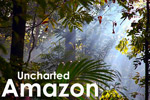The Neotropical otter (Lontra longicaudis) should not be considered threatened by the IUCN Red List, according to a new paper in mongabay.com’s open-access journal Tropical Conservation Science. Currently the species is listed as Data Deficient, but was considered Vulnerable until 2000.
Using a new computational modeling technique—known as a species distribution model (SDM)—to map out the the otter’s range, the authors discovered that the otter likely had a significantly larger range than believed. In fact, this new range is 34 percent greater than the range currently defined by the IUCN and covers nearly half of the Americas.
“New regions to be added include northeastern Brazil, the Andes (in Peru, Ecuador and Colombia), northern Mexico, western Colombia, and Bolivia. These new areas may provide valuable information about the species as well as insight on what really limits the species’ occurrence,” the authors write.
 Neotropical otter in river margins of Brazilian Pantanal. Photo by: Caroline Leuchtenberger/Instituto Federal Farroupilha. |
SDM works by comparing common variables—such as temperature or rainfall—from sites where the species is known across the whole potential habitat. For the Neotropical otter, researchers found the best predictors were high average temperatures and low human population density. Moreover, the scientists found that prime habitat for the otters often occurred in already-established parks.
“In our study we showed that protected areas are significantly more suitable and can help in Neotropical otter conservation, even though they have not been created specifically to protect otters,” the authors write. “The higher suitability values inside the protected areas are not surprising, as many of them were designed based on river basins or river courses.”
The neotropical otter is one of 13 species of otter worldwide with six of these found in the Americas. The Neotropical otter’s habitat converges with the giant river otter’s in much of the Amazon basin. The giant river otter (Pteronura brasiliensis) is considered Endangered by the IUCN Red List.
Citations:
- Defining Neotropical otter Lontra longicaudis distribution, conservation priorities and ecological frontiers
pp 214-229
Marcelo Lopes Rheingantz, Jorge Fernando Saraiva de Menezes and Benoit de Thoisy. Tropical Conservation Science Vol.7 (2): 214-229.
Related articles
Camera trap captures first ever video of rarely-seen bird in the Amazon…and much more

(06/17/2014) A camera trap program in Ecuador’s embattled Yasuni National Program has struck gold, taking what researchers believe is the first ever film of a wild nocturnal curassow (Nothocrax urumutum). In addition, the program has captured video of other rarely-seen animals, including the short-eared dog and the giant armadillo.
Of jaguars and loggers: new film to showcase one of the least-known regions in the deep Amazon

(06/02/2014) In August, three young filmmakers will go on the expedition of a lifetime. They plan to spend six months filming in one of the most remote, most spectacular, and most endangered ecosystems on the planet: the Las Piedras River system. This unprotected swathe of Amazon jungle contains massive anacondas, prowling jaguars, and even uncontacted indigenous people.
Scientist discovers a plethora of new praying mantises (pictures)

(03/19/2014) Despite their pacific name, praying mantises are ferocious top predators with powerful, grasping forelimbs; spiked legs; and mechanistic jaws. In fact, imagine a tiger that can rotate its head 180 degrees or a great white that blends into the waves and you’ll have a sense of why praying mantises have developed a reputation. Yet, many praying mantis species remain little known to scientists, according to a new paper in ZooKeys that identifies an astounding 19 new species from the tropical forests of Central and South America.
Several Amazonian tree frog species discovered, where only two existed before

(03/18/2014) We have always been intrigued by the Amazon rainforest with its abundant species richness and untraversed expanses. Despite our extended study of its wildlife, new species such as the olinguito (Bassaricyon neblina), a bear-like carnivore hiding out in the Ecuadorian rainforest, are being identified as recently as last year. In fact, the advent of efficient DNA sequencing and genomic analysis has revolutionized how we think about species diversity. Today, scientists can examine known diversity in a different way, revealing multiple ‘cryptic’ species that have evaded discovery by being mistakenly classified as a single species based on external appearance alone.
Mother of God: meet the 26 year old Indiana Jones of the Amazon, Paul Rosolie

(03/17/2014) Not yet 30, Paul Rosolie has already lived a life that most would only dare dream of—or have nightmares over, depending on one’s constitution. With the Western Amazon as his panorama, Rosolie has faced off jaguars, wrestled anacondas, explored a floating forest, mentored with indigenous people, been stricken by tropical disease, traveled with poachers, and hand-reared a baby anteater. It’s no wonder that at the ripe age of 26, Rosolie was already written a memoir: Mother of God.